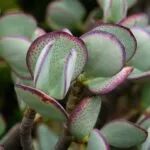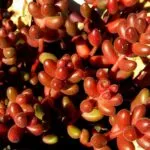Index
Introduction
The King Protea (Protea cynaroides) is one of the most fascinating and distinctive flowers found in nature. Originally from South Africa, this flower enchants with its unique shapes and vibrant colors. Belonging to the King Proteaceae family, King Protea is a species that stands out for its unique beauty and majestic presence in gardens and floral arrangements.
Protea cynaroides, also known as “King Protea”, has large, robust flower heads surrounded by stiff, colorful bracts. Its flowers can vary in shades of pink, red, white and cream, adding a diverse palette to gardens and bouquets. In addition to its exuberant appearance, the King Protea is a symbolic flower, with meanings that permeate cultures and traditions.
Meaning of the King Protea
The King Protea is often associated with meanings such as courage, diversity and transformation. Its presence in South African flora inspires admiration and respect, representing the strength and resilience of nature. In floral arrangements, the King Protea can symbolize the courage to face challenges and the beauty that comes from overcoming obstacles. Its uniqueness and durability make it a popular choice for expressing feelings of admiration and respect at special events and celebrations.
| Common Name | King Protea |
|---|---|
| Botanical Name | Protea cynaroides |
| Family | Proteaceae |
| Plant Type | Evergreen shrub |
| Adult Size | Up to 2 meters high |
| Sun exposure | Full sun |
| Soil type | Well-drained, sandy |
| soil pH | Slightly acidic to neutral |
| Flowering time | Spring to summer |
| Flower color | Pink, red, white, cream |
| Native Area | South Africa |
| Toxicity | Not reported, generally non-toxic |
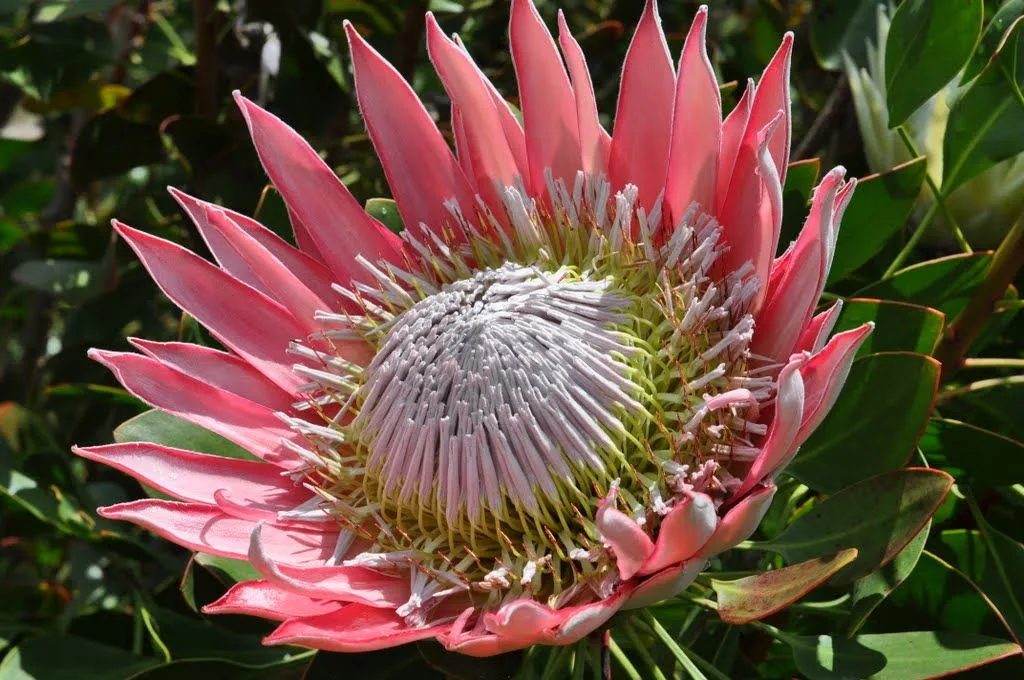
How to care for King Protea
The King Protea (Protea cynaroides) is an impressive flower that deserves special care to thrive in its splendor. Here are some essential guidelines to ensure that your King Protea blooms healthy and lush:
Adequate light
King Protea thrives in direct, intense sunlight. Make sure you position the plant in a spot where it receives at least six hours of sunlight daily. This will ensure vigorous growth and a vibrant display of flowers.
Well-drained soil
The soil for King Protea should be well-drained and preferably sandy. Make sure that the soil allows water to drain quickly, preventing the roots from becoming waterlogged.
Moderate watering
Although the King Protea is drought-tolerant, it is crucial to maintain a regular watering regime, especially during the hottest periods. Avoid soaking the soil and allow the top layer to dry out between waterings.
Controlled temperature and humidity
King Proteas thrive in hot, dry climates. Make sure you provide moderate temperatures and keep the humidity around the plant at balanced levels. Avoid extremes of cold or excessive humidity.
Strategic fertilization
Fertilizing is essential for the healthy development of King Protea. Use a balanced, slow-release fertilizer during the spring. Avoid overdoing it, as King Proteas are sensitive to concentrated fertilizers.
By following these guidelines, you’ll be well on your way to growing a stunning, healthy King Proteain your garden. Adapt the care as necessary and enjoy the unique beauty of this extraordinary flower.
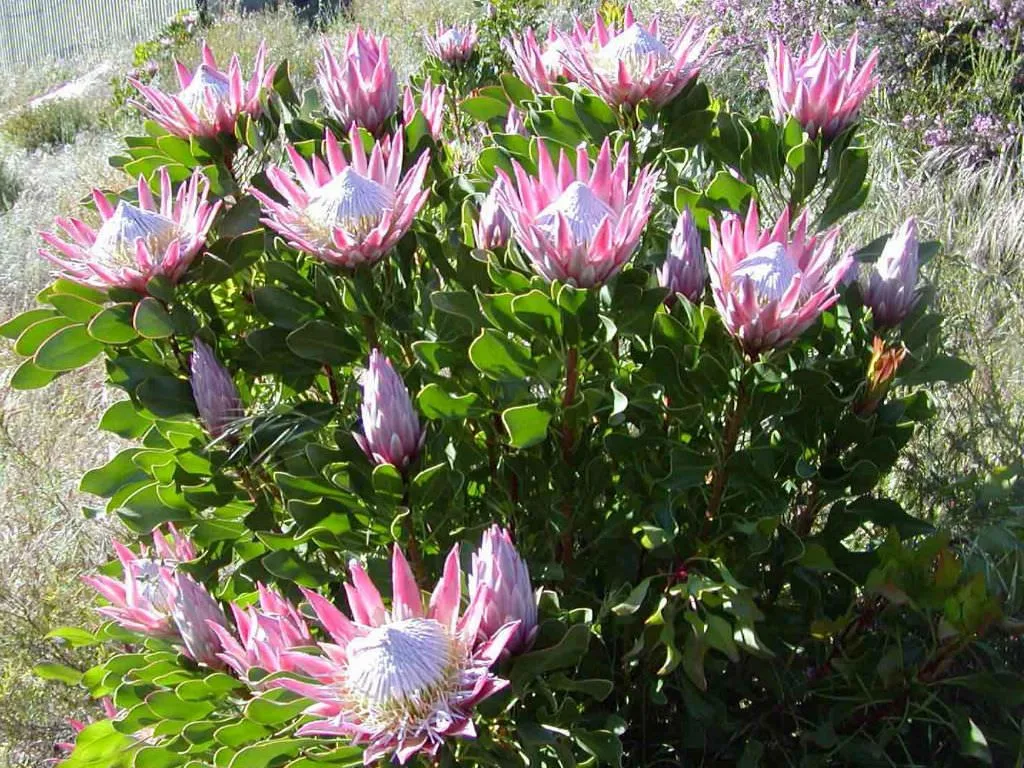
How to make King Protea cuttings
King Protea (Protea cynaroides) propagation can be a rewarding way to expand your garden with this unique flower. Here are the essential steps for creating healthy seedlings:
Choosing Materials
- Selecting branches: Choose healthy, robust branches to ensure a vigorous seedling.
- Appropriate Tools: Use sharp tools to make clean cuts, minimizing damage to the mother plant.
Cutting Technique
- Angle cut: Make diagonal cuts on the chosen branches, preferably in segments about 15 cm long.
- Removing lower leaves: Remove the lower leaves to reduce water loss and encourage root development.
Substrate and planting
- Suitable substrate: Use a light, well-drained substrate consisting of sand and peat.
- Planting the cuttings: Plant the cuttings in individual containers, burying about a third of the length of the cut segment.
How to plant King Protea
Proper planting is crucial to ensure that your King Protea thrives in its new home. Follow these steps for a successful planting:
Site Selection
- Adequate Sunlight: Plant the King Protea in a spot with direct sunlight to ensure healthy growth.
- Well-Drained Soil: Make sure the soil is well-drained, preferably sandy.
Soil Preparation
- Planting Pit: Dig a wide, shallow pit to accommodate the King Protea‘s roots.
- Add Organic Matter: Mix organic matter into the soil to improve fertility.
Planting King Protea
- Removing thecontainer: Carefully remove the seedling from the container, preserving the roots.
- Positioning in the hole: Plant the seedling in the center of the hole, ensuring that the soil level around the plant’s neck is adequate.
Follow these guidelines to ensure a successful propagation process and effective planting of King Protea in your garden. With the right care, you’ll be able to enjoy this extraordinary flower in your own green space.
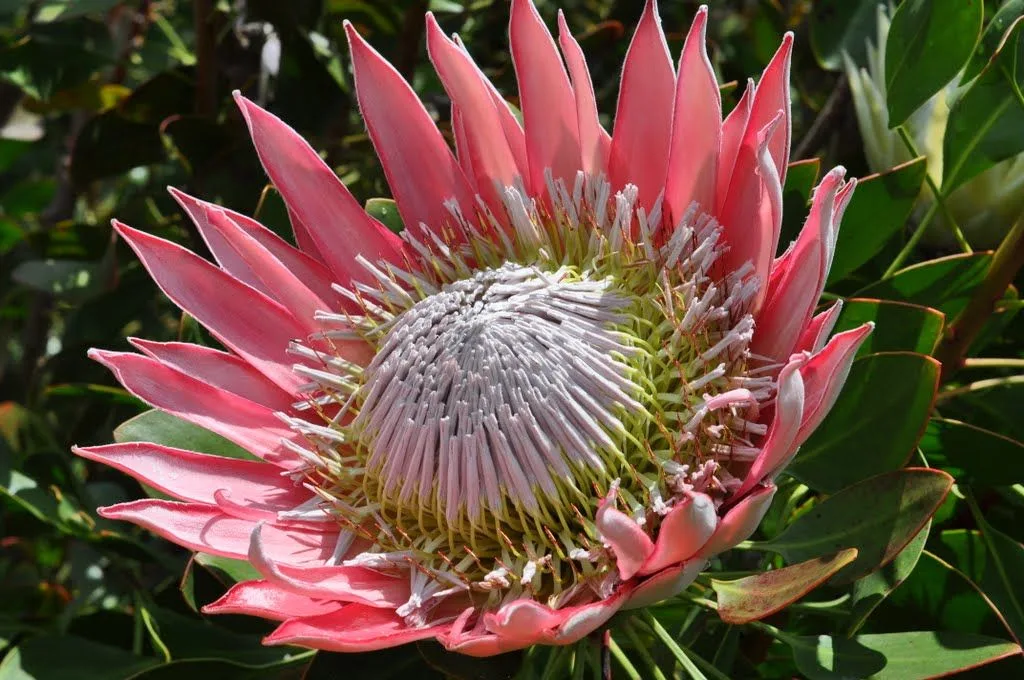
King Protea pests and diseases
King Protea (Protea cynaroides), despite its robustness, can face challenges from pests and diseases. Knowing the most common threats and their solutions is key to keeping your plant healthy. Here is a comprehensive list:
Common Pests
- Mites: Small sucking insects that can cause yellowing of the leaves.
- Aphids: Insects that feed on the sap, leading to damage to leaves and shoots.
- Beetles: Can damage King Protea‘s flowers and leaves.
Common diseases
- Mildew: Fungus that manifests itself as white spots on the leaves.
- Root rot: Can occur due to excess humidity, compromising the health of the roots.
- Rust: Characterized by rust-coloured spots on the leaves.
Common Problems and Their Solutions
Pest Control
- Natural Insecticides: Use insecticides based on neem or neem oil to control mites and aphids.
- Natural predators: Encourage the presence of natural predators, such as ladybugs, to combat aphids.
Disease Management
- Organic Fungicides: Apply organic fungicides to combat mildew, keeping the environment drier.
- Adequate drainage: Avoid the accumulation of water around the roots to prevent rot.
General Measures
- Regular Monitoring: Make regular inspections to identify problems early on.
- Removal of Affected Parts: Remove affected leaves or flowers to prevent the spread of disease.
By following these tips, you can effectively prevent and treat the most common pests and diseases that can affect your King Protea. Maintain diligent care to ensure that your plant remains healthy and lush.

Curiosities and myths about King Protea
Discover fascinating information and debunk some myths related to King Protea (Protea cynaroides). Knowing more about this unique plant can broaden your appreciation for its beauty and peculiarities.
Intriguing facts
- Meaningful Name: The name “Protea” is a tribute to Proteus, a Greek god who could assume various forms, reflecting the diversity of this plant.
- Resistant Flowers: King Protea flowers are known for their durability, often retaining their beauty for weeks after cutting.
- Biodiversity: The Proteaceae family, to which the King Protea belongs, is extremely diverse, including several species and genera.
Myths Debunked
- Difficult to Grow: Although King Proteas require specific care, they are not impossible to grow. With the right knowledge, they can thrive in appropriate gardens.
- Only in Warm Climates: Although they prefer warmer climates, some King Protea varieties can be grown in colder climates, provided they receive the right care.
Beauty and uniqueness
The King Protea is not only an exuberant flower, but also carries with it a rich history and unique characteristics. By understanding its curiosities and debunking myths, you’ll be able to appreciate the uniqueness of this incredible plant even more.
Conclusion
As we explore the fascinating world of the King Protea (Protea cynaroides), we discover that its beauty goes beyond its lush petals. This plant, with its meaningful name and hardy flowers, becomes a distinctive element in any garden. Curiosities reveal its diversity and the richness of the Proteaceae family, while debunked myths highlight that, with the right care, growing a King Protea is not an impossible task, even in less warm climates.
On our journey, we learned the importance of providing the ideal light, soil, water and temperature conditions to ensure that the King Protea blooms in all its splendor. By understanding common pests and diseases, and their solutions, we have strengthened our commitment to the diligent care of this unique plant. We have thus concluded that the King Protea is not just an extraordinary flower, but a vibrant expression of biodiversity and a symbol of beauty that flourishes with dedication and knowledge. To cultivate the King Protea is to embrace not just a plant, but a rich history and an ongoing journey of admiration for nature.
Frequently Asked Questions
What is King Protea?
The King Protea is an exotic flower belonging to the King Protea cynaroides species, native to the southern region of Africa. Known for its unique beauty, the King Protea is characterized by large flower heads and distinctive leaves, making it a popular choice in floral arrangements and landscaping.
How long does King Protea last?
King Protea‘s longevity may vary, but its flowers are notable for their exceptional durability. Under ideal conditions and proper care, King Protea flowers can remain vibrant for several weeks, making them a long-lasting choice for decoration and floral arrangements.
What does the King Protea flower mean?
The King Protea carries deep symbolic meanings and is considered a symbol of courage, diversity and transformation. In many cultures, it is associated with endurance and strength, reflecting the robust and unique nature of this flower. In addition, its name is a tribute to the Greek god Proteus, adding a layer of mythology to its interpretation.


